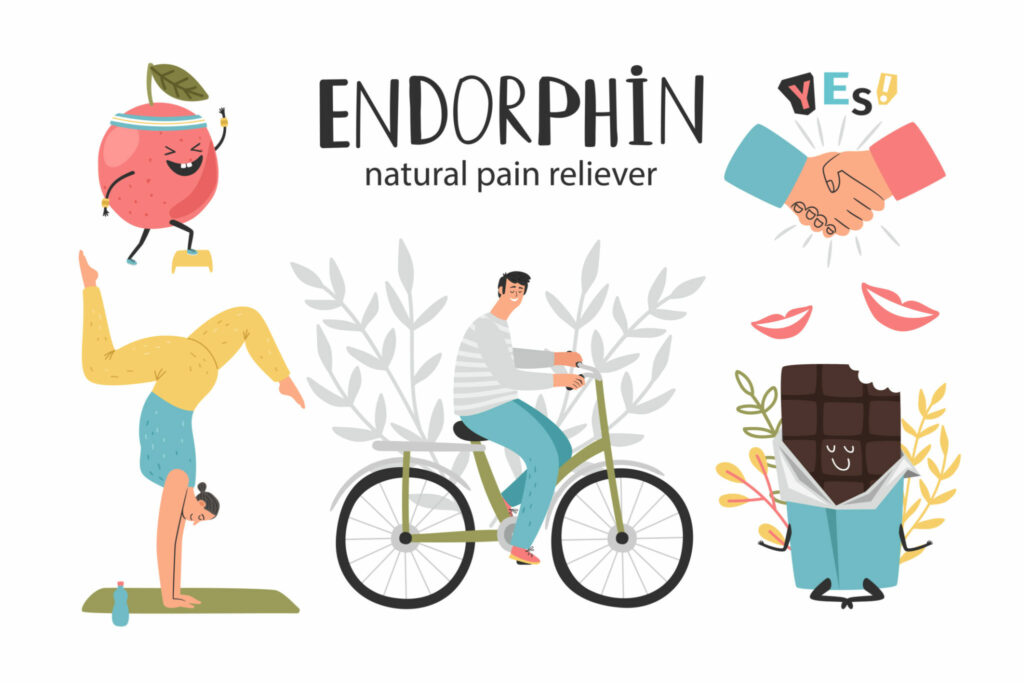
Table of Contents
ToggleIntroduction
In the fast-paced world we live in, the pursuit of happiness is a common thread that connects us all. While there are various avenues to attain joy, one often overlooked contributor to our well-being is the role of endorphins. This article explores the intricate relationship between exercise, endorphins, and happiness, shedding light on the biochemical processes that underlie the profound connection between physical activity and emotional well-being.
Endorphins, short for endogenous morphine, are neurotransmitters produced within the body that act as natural painkillers. They are chemicals that bind to the brain’s opiate receptors, reducing the perception of pain and triggering positive feelings. One of the most notable aspects of endorphins is their ability to induce a sense of euphoria, commonly known as the “runner’s high” when stimulated by exercise.
The link between endorphins, exercise, and happiness is a fascinating interplay that has intrigued scientists and fitness enthusiasts alike. Understanding how exercise stimulates the release of these feel-good neurotransmitters provides valuable insights into the holistic benefits of an active lifestyle.
How Exercise Stimulates Endorphin Release
Physical Activity And Endorphin Production
The relationship between exercise and endorphin release is a dynamic process. When we engage in physical activity, whether it’s a brisk walk, a challenging workout, or a yoga session, our bodies respond by producing endorphins. The intensity and duration of the exercise play crucial roles in determining the amount of endorphins released.
Types Of Exercises That Boost Endorphins
Certain types of exercises are particularly effective in eliciting a robust endorphin response. Aerobic exercises, such as running, swimming, and cycling, are known to be potent triggers. Additionally, high-intensity interval training (HIIT) and strength training also contribute to the surge of endorphins in the bloodstream.
Duration And Intensity Factors In Endorphin Release
The duration and intensity of exercise play a significant role in the magnitude of endorphin release. Longer, more intense workouts tend to result in higher levels of these neurotransmitters. However, even shorter, moderate-intensity activities can contribute to an appreciable boost in endorphin levels, emphasizing the accessibility of this natural mood enhancer.
Effects Of Endorphins On The Brain And Mood
Endorphins As Natural Painkillers
One of the primary functions of endorphins is their role as natural painkillers. When endorphins bind to the opiate receptors in the brain, they diminish the perception of pain and discomfort. This pain-mitigating effect is not only beneficial during and after exercise but extends to various aspects of daily life, contributing to an overall sense of well-being.
Impact On Stress Reduction
Stress, a prevalent aspect of modern life, has detrimental effects on both physical and mental health. Endorphins, by acting as stress relievers, play a crucial role in mitigating the impact of stressors. Regular exercise, as a reliable endorphin-releasing activity, provides a natural and sustainable approach to stress reduction.
Influence On Mood And Emotional Well-Being
The influence of endorphins on mood and emotional well-being is profound. As these neurotransmitters flood the brain during and after exercise, individuals often experience an uplifted mood, reduced feelings of anxiety, and an overall sense of happiness. This natural mood enhancement is a key reason why exercise is often recommended as a complementary strategy for managing mood disorders.
Exercise Modalities For Optimal Endorphin Release
Aerobic Exercises

Aerobic exercises, characterized by sustained and rhythmic movements, are exceptional catalysts for endorphin release. Activities like running, swimming, and dancing elevate the heart rate and trigger the production of endorphins. The sustained nature of aerobic exercise ensures a continuous supply of these neurotransmitters, fostering a prolonged sense of euphoria and well-being.
Strength Training And Endorphin Release
While often associated more with aerobic activities, strength training also has a significant impact on endorphin levels. Resistance exercises, such as weight lifting and bodyweight workouts, induce a stress response that prompts the release of endorphins. This dual benefit of building strength and enhancing mood makes strength training a versatile and effective avenue for promoting overall well-being.
Mind-Body Activities And Endorphin Boost
Mind-body activities, including yoga and tai chi, provide a unique approach to endorphin release. These practices combine physical movement with mindful awareness, creating a holistic experience. The meditative aspects of mind-body activities contribute to stress reduction, while the physical exertion stimulates endorphin production, offering a comprehensive well-being boost.
Individual Variations In Endorphin Response
Genetic Factors
The response to exercise-induced endorphin release can vary from person to person, influenced in part by genetic factors. Some individuals may naturally experience a more pronounced “high” from the same exercise routine that might yield a milder response in others. Understanding these genetic variations highlights the importance of personalized approaches to physical activity.
Personalized Exercise Preferences
Personal preferences in exercise types and intensities also contribute to individual variations in endorphin response. Enjoyment and engagement with a particular form of exercise enhance the overall experience and may result in a more significant release of endorphins. Tailoring exercise routines to individual preferences fosters adherence to regular physical activity.
Consistency In Exercise And Endorphin Levels
Consistency in exercise is a key factor in maintaining optimal endorphin levels. While a single bout of exercise can produce a temporary boost in mood, regular and sustained physical activity ensures a more stable and enduring elevation of endorphins. Establishing a routine that aligns with individual preferences promotes the long-term benefits of a consistent endorphin release.
Endorphins And Mental Health Benefits
Role In Alleviating Symptoms Of Depression And Anxiety
The mental health benefits of endorphins extend to their role in alleviating symptoms of depression and anxiety. The mood-enhancing effects of these neurotransmitters contribute to a more positive outlook, reducing the severity of depressive and anxious feelings. Exercise, as a reliable endorphin-stimulating activity, is increasingly recognized as a valuable component of mental health interventions.
Long-Term Mental Health Implications
The long-term implications of regular endorphin-stimulating exercise on mental health are profound. Engaging in activities that consistently elevate endorphin levels may contribute to the prevention of mental health disorders. Additionally, for individuals already managing mental health conditions, incorporating exercise into treatment plans can complement therapeutic interventions and enhance overall well-being.
Incorporating Exercise Into Mental Health Strategies
Recognizing the synergy between endorphins and mental health, healthcare professionals increasingly advocate for the inclusion of exercise in mental health strategies. Whether as a standalone intervention or in conjunction with other therapeutic approaches, exercise provides a holistic and accessible means of promoting mental well-being.
Endorphins Beyond Exercise: Natural Ways To Boost
Laughter And Endorphin Release
Laughter, often referred to as “laughter therapy,” is another natural way to stimulate endorphin release. The act of laughing triggers the production of endorphins, contributing to a sense of joy and relaxation. Incorporating laughter into daily life, through activities like watching a comedy show or spending time with humor-filled companions, can serve as a delightful and accessible means of enhancing endorphin levels.
Social Connections And Emotional Well-Being
Human connections and social interactions also play a role in endorphin release. Positive social experiences, such as spending time with friends and loved ones, promote feelings of happiness and trigger the release of endorphins. Cultivating strong social connections contributes not only to emotional well-being but also to the natural regulation of neurotransmitters that positively impact mood.
Dietary Factors Influencing Endorphin Levels
While exercise is a primary method for boosting endorphin levels, dietary factors can also influence the production of these neurotransmitters. Consuming foods rich in certain nutrients, such as omega-3 fatty acids and dark chocolate, has been associated with increased endorphin release. Maintaining a balanced and nutritious diet complements the benefits derived from physical activity, contributing to overall well-being.
Practical Tips For Enhancing Endorphin Release
Creating Enjoyable Exercise Routines
The sustainability of an exercise routine lies in its enjoyability. Choosing activities that align with personal interests and preferences enhances the overall experience. Whether it’s dancing to favorite music, exploring nature through hiking, or engaging in team sports, the key is to make exercise a pleasurable and fulfilling part of daily life.
Incorporating Variety In Physical Activities
Variety is not only the spice of life but also a key element in maintaining consistent endorphin release. Incorporating different types of physical activities prevents monotony, challenges the body in diverse ways, and ensures a well-rounded stimulation of endorphin production. From yoga and swimming to cycling and strength training, embracing variety keeps both the body and mind engaged.
Establishing Realistic Fitness Goals
Setting realistic fitness goals aligns with the principles of sustainable and effective endorphin-stimulating exercise. Whether it’s aiming for a certain number of steps per day, completing a weekly workout routine, or gradually increasing workout intensity, establishing achievable goals provides a sense of accomplishment and reinforces the positive association between exercise and well-being.
Conclusion
In conclusion, the interplay between exercise, endorphins, and happiness creates a harmonious cycle that contributes to overall well-being. Exercise, through its stimulation of endorphin release, not only enhances physical health but also plays a pivotal role in promoting mental and emotional wellness. Understanding this interconnection empowers individuals to leverage the natural benefits of endorphins for a happier and healthier life.
Encouraging individuals to adopt a holistic approach to physical and mental well-being is paramount. Recognizing that exercise is not solely a means to an end but a journey that involves the mind and body fosters a sustainable and positive relationship with physical activity. Embracing this holistic perspective ensures that the pursuit of happiness becomes an integrated and fulfilling aspect of life.
FAQs
Q1: What are endorphins?
A: Endorphins are natural chemicals in our body that act like painkillers and make us feel good. When we exercise, our body releases more of these happy chemicals.
Q2: How does exercise make me happy?
A: When you exercise, like going for a walk or dancing, your body releases endorphins. These endorphins interact with your brain, reducing pain and making you feel happy and relaxed.
Q3: Can any exercise release endorphins?
A: Yes, many types of exercise can release endorphins. Activities like running, biking, or even doing yoga can boost your endorphin levels and improve your mood.
Q4: Why is happiness important for health?
A: Being happy is good for your health because it can reduce stress and make you feel more positive. The release of endorphins during exercise not only helps your mood but also has overall health benefits.
Q5: Can I boost endorphins without intense exercise?
A: Absolutely! Even simple activities like laughing, spending time with friends, or enjoying your favorite hobbies can release endorphins. It’s not just about intense workouts – finding joy in everyday activities matters too.
